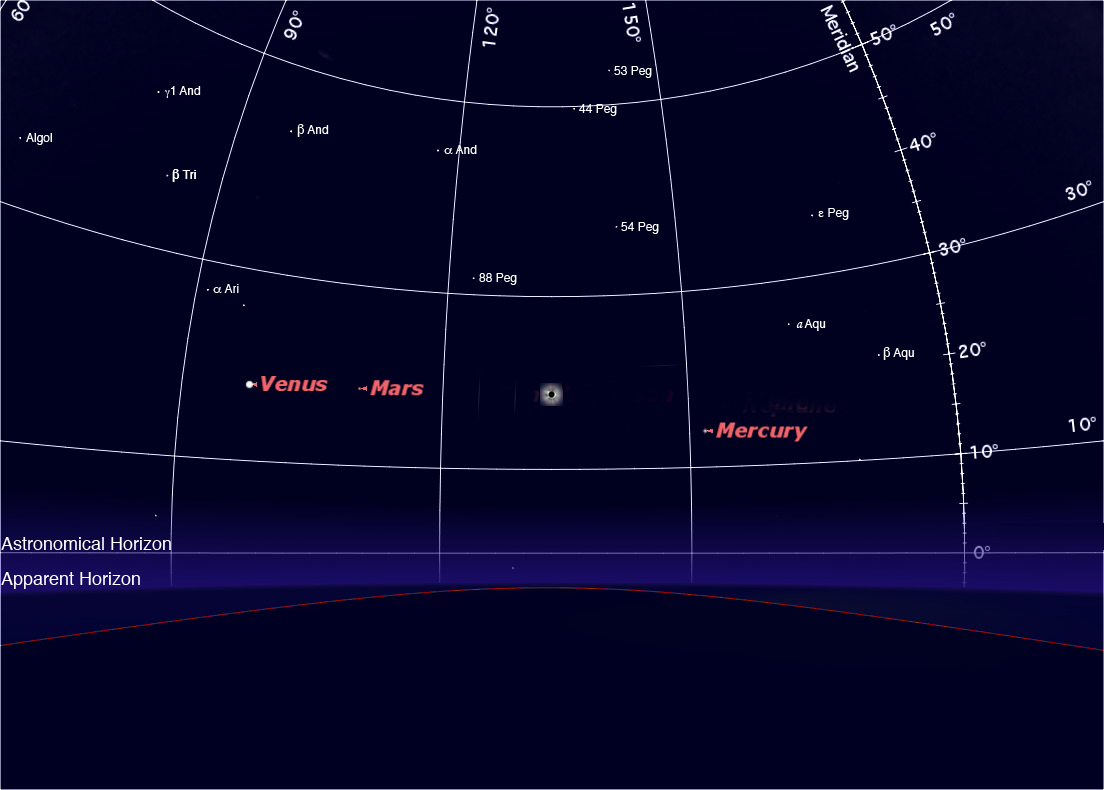The
TSE 2015 MAX Sky at Mid-Totality
The view of the TSE 2015 sky at mid-totality as seen through one of our
EFLIGHT 2015 aircraft windows from 11.3 km above the surface of the
Earth is depicted in the illustration below. From this height
above
mean sea level, the apparent horizon (i.e., the Earth's limb) is
depressed 3.4° with respect to the astronomical horizon.
Looking straight out sun-side aircraft windows to the south-east at an
azimuth of 133° from true north, the totally eclipsed Sun will
stand 22.2° above the apparent horizon (and 18.8°) above the
astronomical horizon. The latter is the true "look up" angle
through the window with the aircraft in straight-and-level
flight.
At mid-totality (09:43:30 UTC), looking toward the 377 km distant
horizon, the outline curve of the southern part of the Moon's shadow
(red line),
seen as a semi-ellipse in perspective projection on the Norwegian Sea,
will be visible with its apex appearing below the Sun. The
apparent motion of the Moon's umbral shadow projected on the Earth (not
in the sky) from second to third contact, as will be seen from our
aircraft, is illustrated IN THIS VIDEO at
17x
real-time speed.
Stars brighter than visual magnitude +3.0 are shown where they will
appear in the sky at mid-totality from EFLIGHT 2015 MAX. This,
probably, is at or beyond the limit of visual perception - but
ultimately depends upon the depth of darkness of the sky during
totality (illustrated darker than expected), which is difficult to
predict.
Naked-Eye Planets:
(1) Looking eastward to an azimuth angle of 97°, at nearly the same
elevation angle above the horizon as the eclipses Sun, Venus will shine
brilliantly at
magnitude -4.0 and will become visible to the unaided eye during the
"totality run" several minutes before the onset of totality.
(2) Mars, 130x fainter than Venus at visual magnitude +1.3,
will be a bit more of a challenge, but during totality should be
visible at an azimuth angle of 110° at very nearly the same
elevation
above the horizon as the eclipsed Sun.
(3) Mercury will be nearly diametrically opposed to the Mars in the
sky,
with respect to the Sun, at an azimuth angle of 152°, a bit
closer to the horizon (elevation angle 14°) but brighter than
Mars by a factor of x 2.5 (visual magnitude -0.34).
Aurorae? To date, there are no (known) reports of any aurorae
witnessed during a TSE - though such is possible with a dark enough sky
at high latitudes, if solar activity is high and conditions right for
an aurora. The northern
hemisphere auroral oval (the location in the Earth's geomagnetic
field at the ionosphere where aurora are most likely to occur, passes
very close to eastern Iceland where we will be observing TSE
2015. While not "expected", if conditions are "right" ... who
knows (but we'll
keep an eye on it!)?
RETURN TO TSE2015 TECHNICAL
INFORMATION PAGE...

